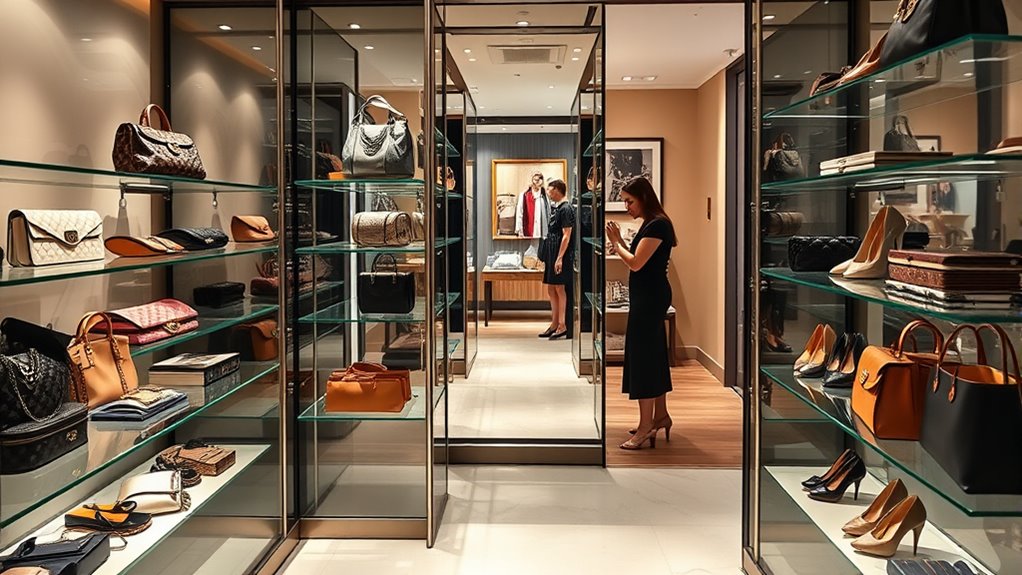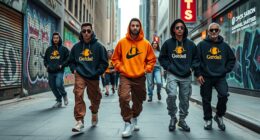The rise of luxury resale shows you can access authentic, high-quality designer pieces without paying full price. It lets you participate in sustainable fashion by reducing waste and extending product life. Thanks to verification processes, you can trust that every item is genuine and reliable. Collaborations and market growth make luxury brands more accessible and exciting, allowing you to stand out with unique vintage or limited-edition pieces. Curious how this movement continues to transform the way you experience luxury?
Key Takeaways
- Luxury resale platforms verify authenticity, ensuring buyers receive genuine, high-quality branded items, making second-hand as trustworthy as new.
- The market offers access to rare, vintage, and limited-edition pieces, providing unique options that surpass mass-produced new items.
- Resale promotes sustainability by extending product lifecycles and reducing waste, aligning with consumers’ eco-conscious values.
- Collaborations and market expansion increase desirability and affordability of luxury items, elevating the status of second-hand shopping.
- Transparency and brand integrity in the resale process boost consumer confidence, proving second-hand luxury can match or exceed new purchase value.

Have you ever wondered why more people are turning to luxury resale markets? It’s not just about finding a good deal; it’s about redefining what luxury means today. Increasingly, consumers seek out options that align with their values, making sustainable fashion a priority. When you buy second-hand, you’re not only acquiring a high-quality piece, but you’re also reducing waste and supporting a more eco-friendly approach to fashion. This shift toward sustainability resonates with many who want to enjoy luxury without the hefty environmental footprint. Plus, luxury resale platforms often verify the authenticity of items, giving you confidence that you’re investing in genuine, brand-name products. This focus on brand authenticity is vital because it ensures that you’re getting what you pay for—authenticity, craftsmanship, and style—rather than counterfeit or subpar replicas. Additionally, the growth of luxury brand collaborations has expanded the variety and desirability of second-hand items, making the market even more appealing to consumers. The appeal of the resale market lies in its ability to offer access to coveted designer labels at a fraction of the original price. But it’s more than just affordability; it’s about making smarter, more responsible choices. When you buy pre-loved luxury items, you’re participating in a circular economy that extends the life cycle of high-end products. This not only helps you stand out with unique pieces that aren’t mass-produced but also supports brands committed to sustainable practices. Many luxury brands are now emphasizing transparency and authenticity, knowing that consumers are more discerning than ever. They want to see proof that their products are genuine and ethically made, which resale markets often provide through meticulous authentication processes. Furthermore, the luxury resale scene is booming because it offers a sense of exclusivity and individuality. You can discover rare vintage finds or limited-edition pieces that are no longer available in stores. This sense of uniqueness appeals to those who want to express their personal style while making environmentally conscious decisions. The rising popularity of luxury resale also reflects a broader cultural shift: people no longer view ownership as just about possession but as about the story behind the item and its impact. When you choose second-hand luxury, you demonstrate a commitment to reducing overconsumption and supporting sustainable fashion initiatives. In essence, the rise of luxury resale isn’t just a trend; it’s a movement towards smarter, more authentic, and environmentally conscious luxury shopping. You get to enjoy the prestige of high-end brands, knowing you’re making a responsible choice that promotes sustainability and brand integrity. It’s a win-win situation—luxury, authenticity, and sustainability all in one package.
Frequently Asked Questions
How Do Luxury Resale Shops Authenticate Their Products?
You might wonder how luxury resale shops authenticate their products. They use thorough authentication processes, which include examining materials, craftsmanship, and serial numbers. Experts also perform counterfeit detection by comparing items to authentic originals and checking for inconsistencies. This meticulous approach guarantees your purchase is genuine, giving you confidence in the quality and value. So, when shopping second-hand, trust that these shops prioritize authentication to protect you from counterfeit products.
What Are the Environmental Benefits of Buying Second-Hand Luxury?
When you buy second-hand luxury items, you support sustainable fashion and eco-friendly shopping. This practice reduces waste by extending the life of products and minimizes demand for new manufacturing, which lowers pollution and resource consumption. By choosing resale, you help decrease the environmental impact of fast fashion, making your shopping more eco-conscious and contributing to a greener, more sustainable future.
How Does Resale Pricing Compare to Original Retail Prices?
Imagine catching a wave—resale prices often ride the tide of market fluctuations. You’ll find that resale pricing typically sits well below original retail prices, sometimes 30-70% less. Pricing trends can vary with brand popularity and condition, but overall, second-hand luxury items offer substantial savings. You get the thrill of luxury at a fraction of the cost, making resale a smart choice amid shifting market dynamics.
What Are the Best Platforms for Buying Luxury Pre-Owned Items?
You should explore designer marketplaces like The RealReal, Vestiaire Collective, and Fashionphile, which offer authentic vintage gems and pre-owned luxury items. These platforms provide secure transactions, detailed item histories, and a wide selection of brands. By shopping on such sites, you get access to high-quality, authenticated pieces at a fraction of retail prices, making them your best options for buying luxury pre-owned items confidently and conveniently.
How Can Consumers Ensure the Quality of Second-Hand Luxury Goods?
To guarantee the quality of second-hand luxury goods, you should verify authenticity, assess condition, and review seller reputation. Follow authentication tips carefully, examine the item’s craftsmanship and materials, and request detailed photos. Always ask for proof of authenticity and inquire about any repairs or wear. Comparing multiple listings helps spot inconsistencies, and reading reviews builds trust. Doing these steps helps you confidently purchase high-quality, genuine luxury items.
Conclusion
As you embrace luxury resale, think of it as planting a seed of sustainability—growing a tree that bears beauty and value anew. Each pre-loved piece becomes a leaf in this vibrant canopy, symbolizing renewal and mindful choice. By choosing resale, you’re not settling for less; you’re cultivating a future where elegance thrives without waste. Together, your stylish act becomes a forest of change, proving that second-hand isn’t second-best—it’s the future in full bloom.









